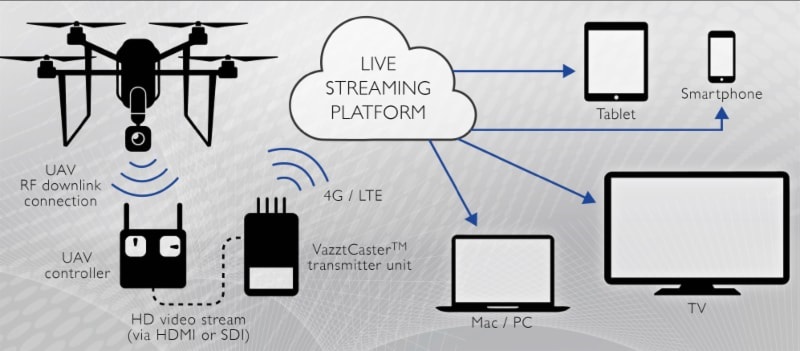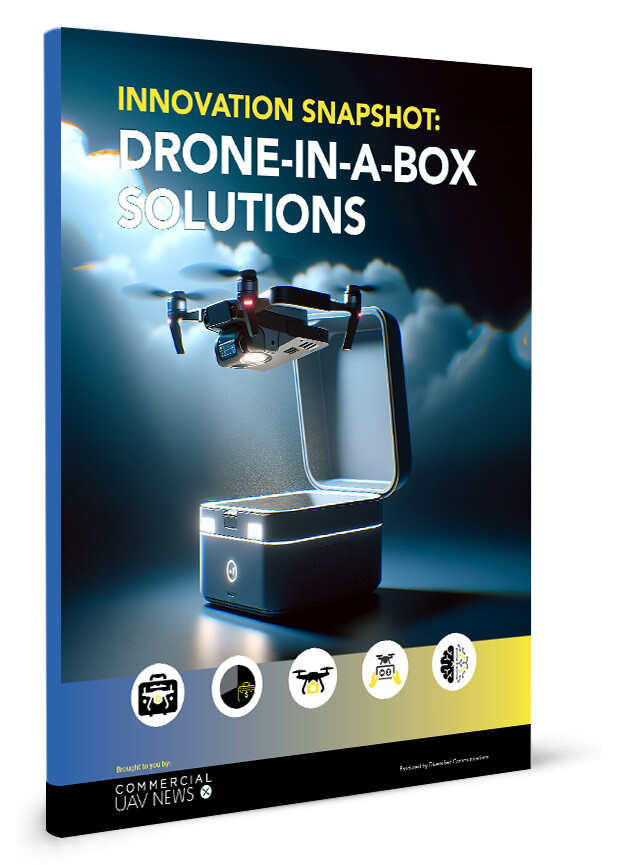When it comes to the transfer of drone data, security is often an issue that is either marginalized or taken as a given, but there are serious dangers in doing either. Luckily, Kencast is focused on bridging geographical gaps between the worksite and office to alleviate and eliminate such issues.
KenCast has developed ultra-reliable software for multicast content, and their secure and efficient
Fazzt technology ensures delivery of live video streams and very large encrypted files. KenCast technology is used in various applications, including public safety and homeland security, since flawless delivery is often the only option for the professionals working in these fields.

Doug Bogan
We were able to catch up with Doug Bogan, Business Manager of Video Solutions at KenCast, to talk about how Kencast products are making a difference. We discuss what sort of challenges Kencast products have helped resolve, their work in the public safety space, what type of professional should be taking a closer look at their products and plenty more.
Jeremiah Karpowicz: We came across your booth at Interdrone where you were undoubtedly able to connect with all sorts of people. What sort of conversations did you have with attendees about your product and presence at the event?Interdrone was a really, really fantastic experience for us. We started attending drone shows with AUVSI’s XPONENTIAL show back in May down in New Orleans. The response we received for our bonded cellular/satellite mobile video transmission products at AUVSI showed us that this is an application of our technology that really meets a need. Interdrone was a continuation of this, especially due to the crossover with the concurrent CTIA show and all the visitors we saw at our booth from that event.
Our Interdrone conversations with attendees and presentation in the Tech Theatre involved how our technology enables reliable, real-time video broadcast and high-bandwidth data upload from out in the field over multiple simultaneous IP connections (cellular or satellite) in a one-button operation device. There really seems to be a product-offering gap right now in the UAV industry in terms of how to get UAV platform field content out the Internet and to digital audiences worldwide reliably and with very low delay. This product meets this worldwide live broadcast need, as well as enables ultra-high bandwidth (75-100+ Mbps) connectivity over cellular networks for file upload to cloud storage platforms.
This seemed to leave a lot of attendees pretty speechless, with many of the corporate attendees saying that they would be in touch after the show. The next-steps discussed with these folks since the show has been very noteworthy, which is always the sign of a successful show.
What sort of challenges have your products helped solve for your customers?As mentioned above, within the mobile video broadcast domain, this technology brings extremely reliable Internet connectivity (video broadcast and file upload capabilities) to areas that have previously been out of reach. With up to 8 embedded cellular modems, these field units combine multiple IP connections to create stable, high bandwidth, with video feeds/data distributed across all of these connections. Multiple cellular carriers are represented in each field unit to ensure strong connectivity capabilities should any coverage gaps exist with a single carrier. So, anywhere a user has cellular service now becomes a strong pipeline to the Internet for video streaming or data transfer. Outside of areas with cellular coverage, satellite modems can be connected via Ethernet cable for turnkey satellite connectivity.
Also, a proprietary patented encoding/compression/transmission protocol yields very low bitrates for HD streaming in these products: 720p or 1080i 30/60 fps requires no more than 4 Mbps with 1.8 seconds of delay…worldwide. H.265 HEVC 4k capabilities requiring about 7 Mbps are also available, with these performance levels setting a new market standard. This is the only H.265 4k bonded cellular field solution out there right now.
Regardless of the industry or application, this technology overcomes the previously unanswered questions of, “How do we reliably stream live video –
fast – to digital audiences worldwide?” and, “How can we reliably upload content and files to cloud storage from out in the field?” Our solution bridges any geographical gap between the worksite and office or command center, thereby reducing on-site personnel costs and inherent wait times.

The VazztCaster EventPro transmitter unit
One client’s work immediately comes to mind when thinking about this question. As part of its offerings, this client provides turnkey live production capabilities – streaming to their live OTT streaming platform – for events of all different natures. Prior to working with this bonded cellular/satellite technology, the client had to turn down many event opportunities, as there was no Wifi or Ethernet connectivity available onsite for these prospective events. Now, the client is able to accept the vast majority of these event proposals, thereby significantly increasing its business opportunities…and ours, too!
Is security an issue enough people are concerned about? How often does it naturally come up in conversations you’re having with potential clients?It depends. Military: yes, sometimes. Private enterprise: no. There is a high level of inherent security within this technology, as any video feed or file is distributed across the multiple IP connections established by the field unit. Also, receive-side decoders are placed within NOC’s behind firewalls. So, in order to intercept the entire transmission, a hacker would need to tap multiple cellular/satellite companies’ networks, capture the various packets on each of the network connections associated with the transmission, and then solve for latency discrepancies. If a hacker is able to pull off that IT feat, then he/she certainly deserves to have the data!
For specific high-security applications, an AES encryption layer can be placed on the data streams for added security (or FIPS-140 via sat modem), but for the most part, there really isn’t a need for this for the reasons previously mentioned.
What can you tell us about your work and involvement in the public safety space?Public safety has always been one of KenCast’s focuses over the past 22 years. With the advent of the mobile video solutions product line here at KenCast, we have been able to create a solution that truly aids in real-time situational awareness initiatives. However, turnkey functionality is absolutely essential in these high-pressure situations. By bridging the gap between the field and operations center in an easily-deployable way, offsite incident commanders and chiefs are now able to see what is going on via computer or smart device (Android or iOS) and relay information back to onsite responders, all in under five seconds of delay, worldwide.
In terms of capture/transmission hardware: we have found that our iPhone app (paired with cellular hotspot devices) is the ground-based tool-of-choice for public safety organizations. The app requires no new hardware for organizations but enables 720p/1080p HD streaming to anywhere in the world, reliably and quickly, all from an iPhone. All that is required of the operator is to turn on the iPhone and cellular hotspot, open the app on the phone and tap the big red streaming button to start/stop the feed. It’s that simple.
Additionally, with public safety organizations deploying drones for aerial situational awareness vantage points, we’re seeing a rising demand for our field units integrated into these platforms’ GCS’s. Simply connect a 720p or 1080i feed via HDMI or SDI out of the GCS into the field unit, and agencies are now able to stream iPhone app and aerial drone content all to a single, unified multi-channel OTT streaming platform.
They have really integrated this into their daily operations and find this technology extremely helpful, which is really exciting to see.
The Fire Department of New York's (FDNY) use of a live broadcasting platform to aid in fighting fires is really interesting. Did this use come from an opportunity you were able to present the FDNY, or from a need they had identified?We had worked with the FDNY a few years back on a smaller video-based project. They came back to us in May 2015 expressing interest in this new mobile video solutions technology and wanted to test out what we had. Well, a demo turned into KenCast adapting the existing technology to create a bespoke public safety adaptation. They have been relying on (and growing!) the platform ever since.
Can other fire departments look to this example in order to create something similar? Could this be a catalyst in the development of other situational platforms for first response professionals?Oh, absolutely. Regardless of the industry (public safety/first response, oil & gas, power utilities, construction, insurance, military, etc.), wherever there is a need for real-time surveillance and/or inspection, this technology is a cost-effective solution to bridge that geographical gap, thereby significantly saving time and money.
What type of professional should be taking a closer look at your products?For this technology, we’re really targeting SOCOM communications division leaders (military), project managers, chief operations engineers, and heads of drone divisions within the industries mentioned above. These are the folks who seem to be stymied by the lack of reliable Internet connectivity out in the field, understand the immense value-add of this technology, and have significant clout in the eyes of decision-makers (or are the decision-makers themselves) within their respective organizations.
This technology is extremely advanced from an engineering standpoint, yet the concepts behind it and its ease-of-use could not be simpler. It’s really a game-changer for any organization struggling with Internet connectivity out in the field.
If you'd like to learn more about Kencast solutions, get in touch with them by sending an email to [email protected] 






.png.small.400x400.png)









Comments